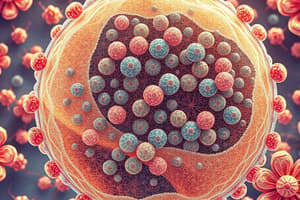Podcast
Questions and Answers
Draw a phospholipid. Label the three major parts.
Draw a phospholipid. Label the three major parts.
Phosphate group, glycerol, and fatty acid tails.
Which part of a phospholipid is charged or polar?
Which part of a phospholipid is charged or polar?
Phosphate group and glycerol.
Which part of a phospholipid is nonpolar?
Which part of a phospholipid is nonpolar?
Fatty acid tails.
Where does a cell membrane come in contact with water?
Where does a cell membrane come in contact with water?
Why do phospholipids surrounding the cell form a bilayer?
Why do phospholipids surrounding the cell form a bilayer?
What is the function of cholesterol in the phospholipid bilayer?
What is the function of cholesterol in the phospholipid bilayer?
What is the function of proteins in the phospholipid bilayer?
What is the function of proteins in the phospholipid bilayer?
What is the function of carbohydrates in the phospholipid bilayer?
What is the function of carbohydrates in the phospholipid bilayer?
In what way is a membrane fluid?
In what way is a membrane fluid?
Draw a picture to represent selective permeability.
Draw a picture to represent selective permeability.
Flashcards are hidden until you start studying
Study Notes
Phospholipids and Cell Membrane Structure
- Phospholipids are composed of three major parts: a phosphate group, glycerol, and two fatty acid tails.
- The phosphate group and glycerol are charged or polar, making them hydrophilic (water-attracting).
- The fatty acid tails are nonpolar, hydrophobic (water-repelling) components.
Cell Membrane Interaction with Water
- Cell membranes interact with water at two locations: the cytoplasm inside the cell and the extracellular fluid outside the cell.
Bilayer Formation
- Phospholipids arrange into a bilayer because the polar heads face outward towards the watery environments while the nonpolar tails face inward, minimizing contact with water.
Role of Cholesterol
- Cholesterol molecules are embedded within the phospholipid bilayer and serve to strengthen the cell membrane, enhancing its stability and fluidity.
Protein Functions
- Membrane proteins assist in transporting materials across the membrane and are integral to maintaining the cytoskeleton structure.
Carbohydrate Functions
- Carbohydrates attached to proteins and lipids in the membrane play a crucial role in cell recognition and identifying different cell types.
Membrane Fluidity
- The membrane exhibits fluidity, allowing phospholipids to move laterally and slide past one another, contributing to the dynamic nature of the membrane.
Selective Permeability
- Cell membranes possess selective permeability, regulating which substances can enter or exit the cell, a critical function for maintaining homeostasis.
Studying That Suits You
Use AI to generate personalized quizzes and flashcards to suit your learning preferences.




